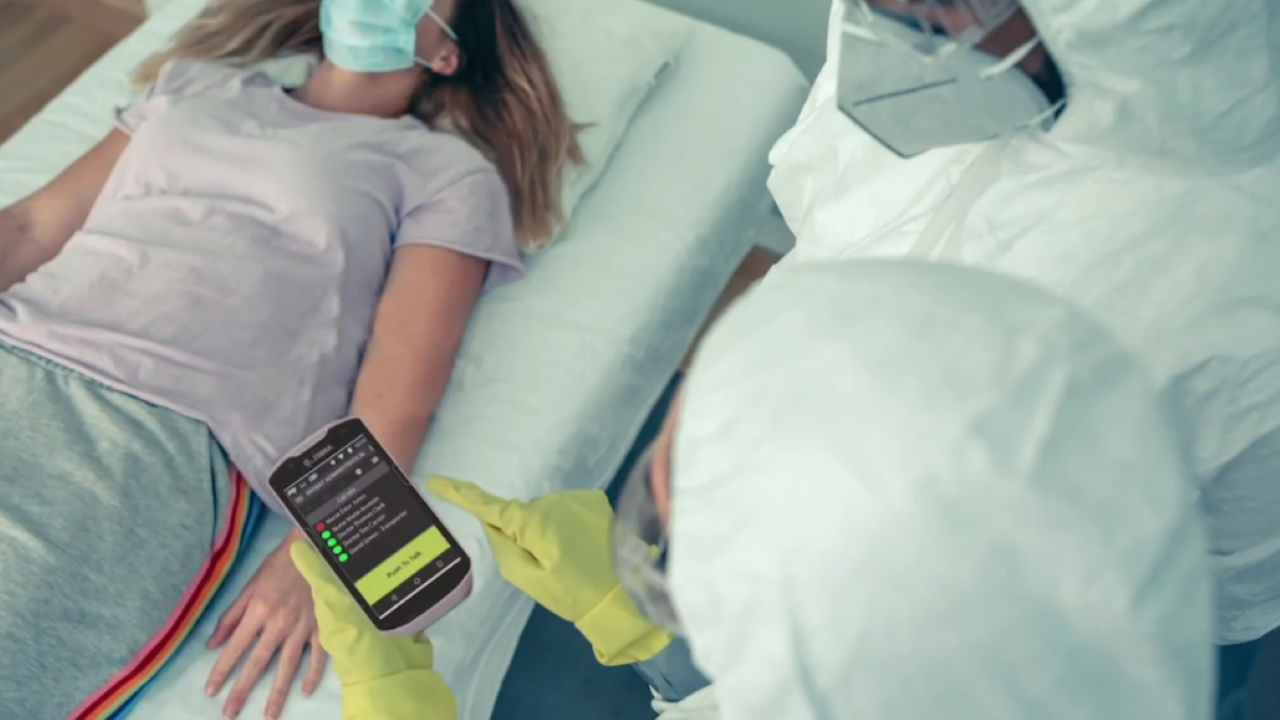
Ask the Experts: What Do Hospitals Need to Know Before Implementing Healthcare Technology in Tents and Other Temporary Care Facilities?
Last week, you heard James Woo, Zebra’s Asia-Pacific (APAC) Healthcare Practice Lead, as well as two of Zebra’s North America Healthcare Account Managers, Kathy Marchant and Katie Johnson, talk about what it takes to stand up a temporary hospital, technologically speaking.
In the second part of our interview below, these experts share some of the key challenges and best practices derived from the front lines of these projects in the hopes that other healthcare systems can learn from them as work continues to expand global care capacity.
Your Edge Blog Team: You’ve all been involved in setting up similar workflows and technology systems in a traditional hospital before. How are things different in this new acute environment?
James: Most hospital staffing, workflow, equipment and technology decisions are based on treating patients with problems ranging from non-infectious, critical conditions such as heart attacks and strokes to major trauma cases arising from motor or industrial accidents and viral infections such as hepatitis C. The new acute environment arising from COVID-19 forces them to re-think and review their existing staffing, workflows and technology adoption. They must be able to scale-up quickly should another major disruption occur and cause another secondary health crisis to occur, resulting in a surge in patient inflow similar to the current COVID-19 pandemic.
Katie: To James’ point, though, this is uncharted territory. Many customers I’ve been working with in the U.S. didn’t necessarily know what they needed technologically speaking when they first started scoping these temporary hospital projects. They knew they needed certain workflow capabilities, but they weren’t sure if the same hardware that they used inside the walls of a traditional hospital would be able to connect in a remote environment. Of course, there were network infrastructure and software considerations too. Could they implement a similar IT infrastructure capacity in the field or use the same mobile apps to facilitate COVID-19-specific workflows. And could they do all of these in two or three weeks knowing that it would normally take three to six months?
Kathy: Another challenge is the inability of solution providers to be on site to support healthcare workers’ efforts in the same capacity they would for other technology implementations. I used to be in a hospital at least once a week with our Sales Engineer, and this proved to be so valuable when understanding the customer’s application and providing support during solution implementation and refinement. Almost everything must be remote now due to travel restrictions and social distancing, so it is a bit harder.
Your Edge Blog Team: What would you say are the best practices derived thus far?
James: Hospitals have to review their current practices, processes and level of technology adoption to ensure that there is a “force multiplier” factor built into their design. When waging a war on a viral outbreak, maintaining status quo at pre-COVID-19 readiness is not an option unless your hospital has the right level of adoption in place to handle the surge and the ability to share data with government agencies in a near real-time manner to support public safety decision making.
Though, if I had to recommend one pillar among the three key pillars (process, people, technology) to scale up first, it would be technology – and mobile technology in particular. Doing so provides the much-needed force multiplier effect when the need arises, enabling current staff to handle higher volumes of patients received in a health crisis in a safer and more efficient manner. They can collaborate at a multi-disciplinary level, receive and act on real-time patient monitoring alerts, track the use of critical assets and/or quickly verify patient identities and health status for quick segregation and accurate treatment. Let me clarify that the other two pillars (process and people) are to be reviewed and worked on so that the three pillars work hand-in-hand to extract maximum benefits from the adoption of new healthcare technologies.
Of course, under infectious conditions, there’s an added advantage to using mobile devices to carry out daily tasks: social distancing. You can scan wristbands and barcodes – and communicate – from afar to minimize the transmission risk between caregivers and patients.
However, it is equally critical to regularly wipe down mobile devices, scanners and printers throughout the day using medical-grade disinfectants, as explained in this video:
Your Edge Blog Team: Kathy and Katie, have there been any additional learnings in North America?
Kathy: At this early stage I would say that the biggest lesson learned in the U.S. is that we were not prepared as a country or healthcare system to handle this type of pandemic. On a positive note, I have seen a community of vendors, healthcare providers and even members of the public come together to do what is needed to get the job done with our limited resources. Personal agendas have been put aside.
Katie: Creating emergency action “kits” may be a fantastic solution, especially for automating specimen labeling to improve workflow accuracy. We’ve also learned a lot about the logistics of sourcing and implementing technologies in remote facilities. It takes an army to do what we’re doing. Don’t be afraid to tap into the collective expertise and resources of multiple solution providers, supply chain partners and distributors as well as healthcare systems’ many different clinical, administrative and IT stakeholders – those you consider trusted advisors.
Your Edge Blog Team: James, in your opinion as a former hospital CIO, what is the biggest risk of not acting fast to expand care capabilities?
James: As we’ve seen multiple times in the past few months, the sudden increase in the volume of patients seeking treatment can quickly overwhelm a healthcare facility. When it lasts an extended period of time, possible lapses in patient safety and a decreased quality of care may occur. Many areas found to suffer from such prolonged surge in patient volume include:
- Staff Welfare: It takes time to recruit additional trained healthcare staff to meet that surge in demand. Meanwhile the staff-patient ratio increases by multiple fold and regular staff is required to work multiple shifts, leading to burnout and the increased risk of oversights affecting patient safety.
- Equipment Utilization: Clinicians or nurses are unable to locate critical equipment quickly in an already-stressful environment creating inefficiencies in the allocation of these limited assets.
- Bed/Ward Occupancy: High bed occupancy leads to patients being triaged and assigned to hallways, prolonged care wait times and everyone running all over the place, potentially leading to chaos.
- Treatment Decisions: Testing facilities that are unable to turn around results quick enough leave staff undecided about the best course of treatment.
- Data Accuracy: In a rush, staff might make mistakes in testing or checking patient records.
Several things can result from such a scenario:
- Very sick patients could be overlooked in the emergency room as hospitals work to manage the large volume of patients in their care.
- Patient safety can be compromised in terms of unverified identity or treatment decisions and actions.
- There can be a lapse in communications – either due to delays or miscommunication.
- Results could take longer than necessary to reach front-line healthcare staff.
Your Edge Blog Team: What advice would you give to those who are waiting to see what happens before actually starting their builds or those who are reverting to pen and paper processes because they’re still relying on traditional – often prolonged – procurement methods to acquire technology?
James: Take the time now to review your network infrastructure, current level of technology adoption and future adoption plans/roadmap. Ask yourself if you have the solutions to meet your end-to-end needs now and in the coming years. And do you have trusted solution partners with the capability to address your short-term and long-term technology needs? We don’t know how long the COVID-19 is going to last or if it will resurge each year in a different form. Most media have reported that much of the hospital challenge in such a healthcare pandemic is the lack of PPE, ICU equipment, medicine and even critical care doctors, etc. My advice is to look at your healthcare technology to ensure it does not add to the previously mentioned resource issues. On the flip side, you could use healthcare technology to mitigate your operational issues arising from a surge in patient volume and take them out of play. In other words, it is critical to improve your healthcare institution’s technology readiness now so that the institution is prepared for another future healthcare crisis. Don’t wait until things get bad to make changes because you may not have the focus or time to do. Stay proactive, especially when it comes to technology given that its “force multiplier” effect can provide the relief and efficiency boost to staff when the workload becomes challenging.
###
Editor’s Note:
Learn more about how Zebra is working to empower front-line heroes at www.zebra.com/heroes

Zebra’s “Your Edge” Blog Team
The “Your Edge” Blog Team is comprised of content curators and editors from Zebra’s Global PR, Thought Leadership and Advocacy team. Our goal is to connect you with the industry experts best-versed on the issues, trends and solutions that impact your business. We will collectively deliver critical news analysis, exclusive insights on the state of your industry, and guidance on how your organization can leverage a number of different proven technology platforms and strategies to capture your edge.




